
CiSRA Puzzle Competition 2010 - Solutions
5D. 3d
Firstly, cut out the eight shapes and fold each one into a three-dimensional solid. They form irregular tetrahedra. You might want to tape each one of the shapes so they hold their solid shape.
Two of the faces of each tetrahedron are isosceles right triangles. These faces are decorated with dots, numbers, and small coloured rectangles with what resemble screw-heads on them. Most of these faces are shaded a pastel colour; two are white.
The other two faces of each tetrahedron are right triangles, with side lengths in the ratio 1:sqrt(2):sqrt(3). These faces are all white, with a big digit 0 or 1 on them, and three coloured dots in the corners. The coloured dots consist of either a black dot surrounded by a coloured ring, or a coloured dot surrounded by a black ring.
It is possible to take six of the eight shapes and assemble them into a cube. The patterns on the isosceles faces can be used to distinguish which pieces to use, and where to place them relative to one another. By using different subsets of six pieces selected from the eight, you can assemble three different cubes. First we'll give the pieces numbers (shown in red) so we can identify them:
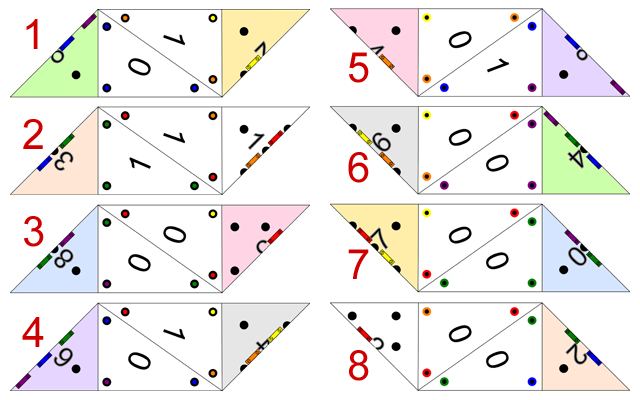
Using pieces 1, 3, 4, 5, 6, 7, and looking only at the face colours produces a cube with consistently coloured pastel faces. Reading the faces in the following photos clockwise from the top, we have yellow, light blue, pink on the left, and light purple, light green, grey on the right.
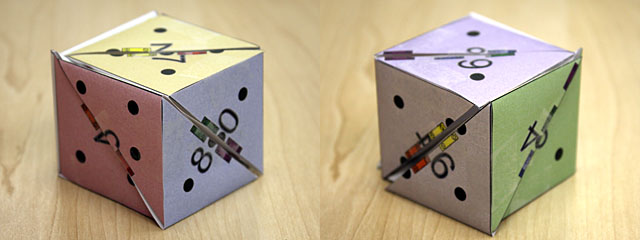
Using pieces 2, 3, 4, 6, 7, 8, and looking only at the large black dots produces a standard six-sided die. Reading the number of spots on the faces in the following photos clockwise from the top, we have 2, 3, 1 on the left, and 5, 6, 4 on the right.
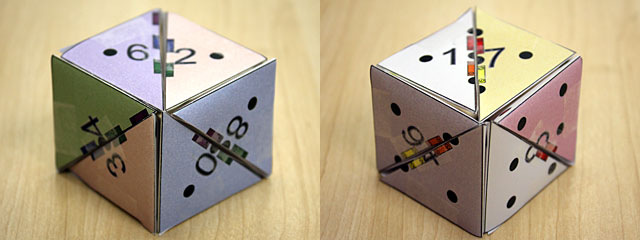
Using pieces 1, 2, 4, 5, 6, 8, and looking only at the large numbers produces a backgammon doubling cube. Reading the large numbers on the faces in the following photos clockwise from the top, we have 8, 2, 4 on the left, and 16, 32, 64 on the right.
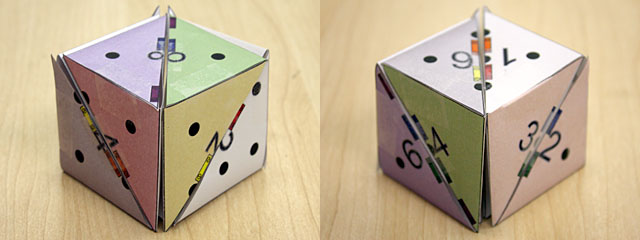
On each of these cubes, some of the small coloured rectangles line up to create what look like hinges. On each cube there are two colours for which all of the hinge halves of those colours line up to make complete hinges. Sometimes one hinge of another colour may also line up, but generally the hinge-halves of the other four colours don't line up properly.
- The pastel coloured cube has a group of 3 purple hinges and a group of 2 yellow hinges.
- The die has a group of 3 green hinges and a group of 2 red hinges.
- The doubling cube has a group of 3 blue hinges and a group of 2 orange hinges.
The white faces with the large digits and the coloured dots on them are hidden inside the cubes. If you imagine the pieces in each cube to be hinged at one of its set of coloured hinges, you can open the cube up to reveal parts of the inside. The rule here is that the coloured dots on the inside faces act as snap fastener studs, holding some faces together. The snaps only "work" if they form a matching pair of the same colour as the hinges you are currently considering. Snaps of colours other than the hinges you are considering are irrelevant.
Each cube can be opened in two different ways, using first one group of coloured hinges, then the other group of hinges. When unfolded using the hinges and respecting the snaps of the matching colour, each cube turns into a different shape, which reveals a series of six of the large "0" and "1" digits. The results are:
- Coloured cube, purple hinges and snaps: 000101
- Coloured cube, yellow hinges and snaps: 000001
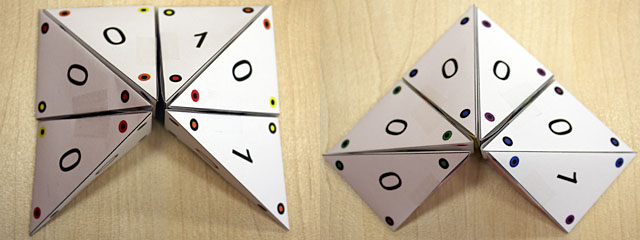
- Die, green hinges and snaps: 010001
- Die, red hinges and snaps: 000010
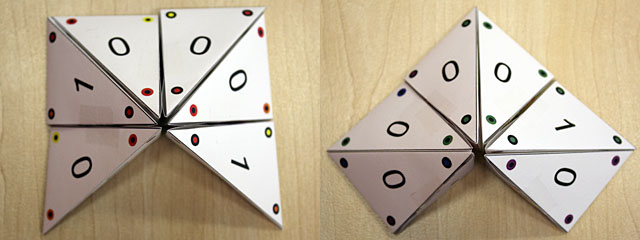
- Doubling cube, blue hinges and snaps: 010101
- Doubling cube, orange hinges and snaps: 010010
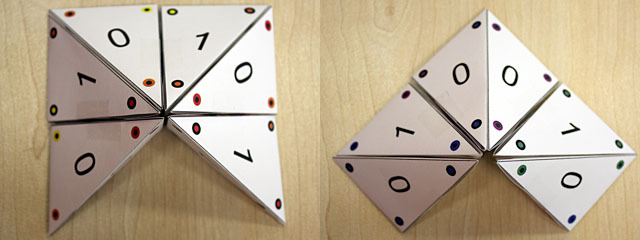
Each of the six colours therefore produces a 6-bit binary string. Converting these to decimal numbers and then to letters of the alphabet produces the following, ordered by colour in the standard visible spectral sequence:
| Colour | Binary | Decimal | Letter |
|---|---|---|---|
| Red | 000010 | 2 | B |
| Orange | 010010 | 18 | R |
| Yellow | 000001 | 1 | A |
| Green | 010001 | 17 | Q |
| Blue | 010101 | 21 | U |
| Purple | 000101 | 5 | E |
The letters spell BRAQUE, the surname of the artist who, along with Pablo Picasso, pioneered the artistic style of cubism, and the answer to the puzzle.
Puzzle design notes: When presented to our test solvers, this puzzle was considerably harder. Instead of a pastel coloured cube, the third pattern was that of an unsolved Rubik's cube. This caused horrible blind alleys, as the test solvers tried to solve the Rubik's cube and figure out how that fit into the puzzle. Also, the puzzle title "3d" was considered "potentially far too hinty" by the designer, so the test solvers never saw the title either. Both of these things were changed to make the puzzle easier for the competition. Even so, we knew it was a very difficult puzzle, so congratulations to the teams who solved it.